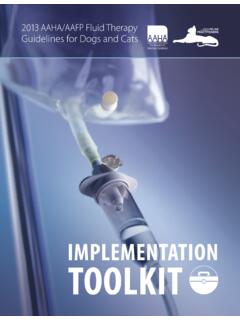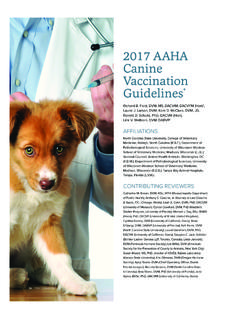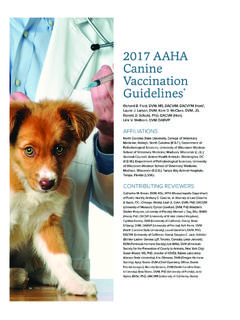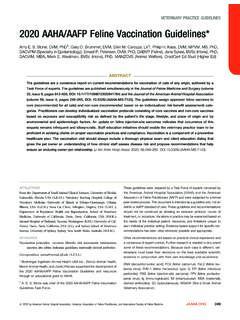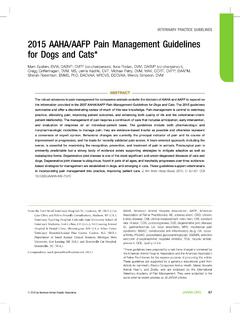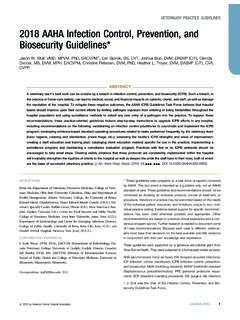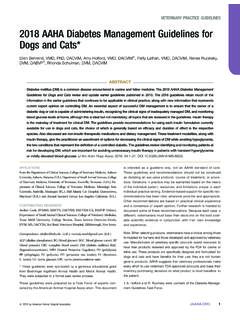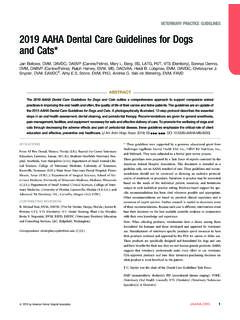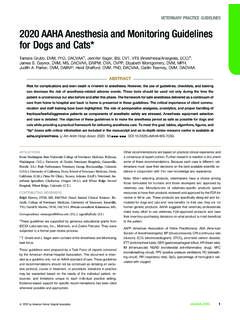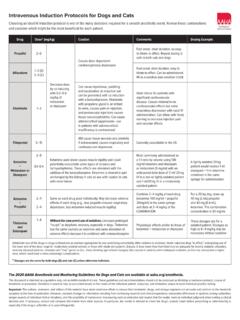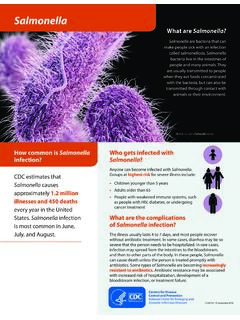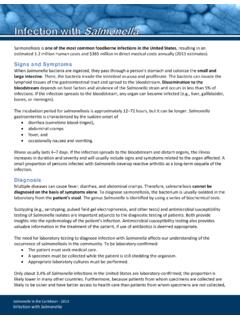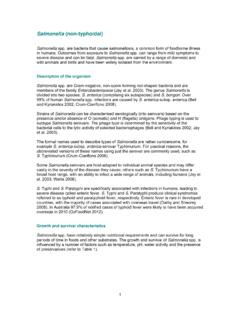Transcription of Keep It Clean - AAHA
1 Infection Control and Biosecurity in Veterinary Medicine 1 keep It Clean Infection Control and Biosecurity in Veterinary Medicine BY THE NUMBERS 2017 American Animal Hospital Association ( ). All rights importance of infection control and biosecurity 2A brief history of disinfectants 27 Steps to good infection control 69 Common disinfection mistakes 125 Disinfection myths 15 Small steps, big reasons 16 Glossary of disinfection and biosecurity terms 18 Control and Biosecurity in Veterinary Medicine 1 Infection prevention and biosecurity are an essential part of patient care and should play an important role in the daily practice of veterinary medicine. All veterinary practice team members, from veterinarians to kennel attendants, must maximize measures to prevent the spread of infectious pathogens as part of the care they provide to their patients and clients.
2 An effective infection prevention and biosecurity program is an integral part of the One Health Initiative, a movement put into place to protect humans, animals, and the environment from the negative impact of disease outbreaks are costly and have devastating short- and long-term effects for animal health professionals and animal care facilities. An infection control and biosecurity plan provides an established mechanism to protect against outbreaks and disease transmission, not just between animals but also between animals and those tasked with caring for them. Environmental surfaces, fomites, and medical devices play an important role in the transmission of pathogenic microorganisms, as many of these pathogens can survive on these surfaces for prolonged periods of time. Developing and implementing an effective infection prevention and biosecurity plan requires a committed team trained to execute a clear, sequential set of well-timed tasks, with each member having assigned areas of and disinfection of environmental surfaces, fomites, and medical devices is a vital part of any facility s infection prevention and biosecurity program.
3 Choosing the right disinfectant can both ensure the overall success of a biosecurity program and have a dramatic impact on facility maintenance costs and employee health. This booklet will guide you in the selection of the ideal disinfectant and assist you in establishing and maintaining proper protocols to prevent the spread of pathogens within your facility. Developing an infection prevention and biosecurity program can be distilled into seven simple steps: 1 . Clarifying the roles and responsibilities within your veterinary practice team 2 . Identifying levels of biosecurity risk for different areas of your facility 3 . Accounting for the mode of transmission for possible pathogens 4 . Choosing the right disinfectant for your practice s needs 5 . Training your entire staff on proper use of the specific disinfectant you choose 6 . Making the disinfectant you choose readily accessible 7 . Setting up routine quality-control measuresLucas Pantaleon, DVM, MS, DACVIM, MBAS enior Clinical Veterinarian Advisor, Virox Animal HealthA note from AAHA: AAHA recognizes the need for veterinary professionals to be educated about the most current research and information relative to infectious disease control and biosecurity.
4 AAHA is working with Virox Animal Health to provide you with the most effective advice relative to biosecurity for veterinary practices. This booklet is the first of our communications and educational materials on this subject in the years to come. These materials will empower your practice s infection prevention team to review and improve current protocols on a regular basis. We feel strongly that infectious disease prevention and control is important to veterinary medicine and the health of our pets. 2 Infection Control and Biosecurity in Veterinary MedicineThe Importance of Infection Control and Biosecurity Comprehensive infection control and biosecurity play an increasingly important role in the daily practice of veterinary medicine. Veterinary teams already make critical efforts toward infection control. Using standards of practice and other veterinary guidelines, your team already does everything from vaccination to hospitalization, including isolation of infected patients, systematic hand-washing, use of personal protective equipment, and instrument sterilization.
5 Teams also provide education to families with pets and infection surveillance to county, state, and federal disease control officials. Keeping pets, families, veterinary professionals, and communities safe from pathogens requires a comprehensive approach. Biosecurity in veterinary medicine is part of the One Health concept it approaches human, animal, and ecosystem health as related, not separate, issues for the future of everyone and everything on the planet. However, there is one element of infection prevention and control that can be overlooked in the hubbub of a typical day at a veterinary facility: strict and effective cleaning and s easy to think a practice s cleaning protocols are good enough if you re not seeing the spread of infectious diseases or hospital-associated infections (HAIs). But just one patient catching an infection while at your facility often ends up costing more than using a state-of-the-art disinfectant and proper protocols for prevention.
6 One of the most documented instances of an animal hospital incurring significant financial costs due to the outbreak of an infectious disease is that of a large animal veterinary teaching hospital. Direct costs of approximately $ million resulted from a single large outbreak of salmonellosis , which was attributed to an ineffective infection control addition, the potential costs to clients also should not be overlooked. Let s take canine parvovirus and canine influenza as examples. In addition to patient suffering and the emotional stress placed on families, clients could face significant treatment costs if their pet picks up either of these viruses at the hospital: Average cost of parvovirus per canine: $1,467 Most expensive case of canine parvovirus: $11,063 Average cost of influenza per canine: $534 Most expensive case of canine influenza: $5,1472 Careful evaluation of disinfectants and implementation of proper cleaning practices can prevent these kinds of infections and the added costs associated with treating them.
7 A Brief History of Disinfectants Disinfection inside an active veterinary practice might seem like the lowest-tech part of a high-tech job, but disinfectant technologies continue to become more advanced. If thinking of disinfection only brings to mind chlorine bleach, you might be surprised at how disinfectants have changed over the past 100 years. Each kind of disinfectant single active ingredient or combined chemicals carries its own advantages and disadvantages. Chlorine bleach, which was used back in the 1920s, offered broad germicidal efficacy, but was also unstable, a poor cleaner, and came with health hazards for staff and patients. Control and Biosecurity in Veterinary Medicine 3 Hydrogen Peroxide (+) safe, sustainable ( ) unstableOrganic Acids (+) safe, sustainable ( ) limited efficacyQ UATs (+) broad efficacy, safe ( ) slow actingAlcohol (+) safe ( ) slow acting, poor cleanerAldehydes (+) broad efficacy ( ) health hazards, environmental issuesPeracetic Acid (+) fast acting ( ) health hazardsPhenolics (+) kills TB ( ) health hazardsBiguanides (+) broad efficacy ( ) human and environmental health hazardsAccelerated Hydrogen Peroxide (+) broad efficacy, fast acting, safe, sustainable1920sChlorine (+) broad efficacy ( ) unstable, poor cleaner, health hazards1940s1970s1950s1990s1960s2000sDIS INFECTANTS BY DECADE.
8 PLUSES & MINUSES(+) indicates the pros of using this type of disinfectant, ( ) indicates the cons of using this type of disinfectant 4 Infection Control and Biosecurity in Veterinary MedicineSo-called quats (quaternary ammonium compounds), which were first introduced in the 1970s and are still widely used today, work great on influenza, Salmonella, Staphylococcus, and fungi, but don t work as well on heartier nonenveloped viruses like canine parvovirus. Quats also require longer disinfection contact times (the length of time the surface needs to remain wet to be disinfected). Furthermore, the active agent in quats is known to bind to cotton cloths, which causes the disinfectant chemical to stay on the cloth rather than transfer onto the surface being wiped. In addition, research has shown that some disinfectant chemistries can leave behind a sublethal concentration of the active ingredient after evaporation. This has the potential to lead to antibiotic resistant , and potentially chemical- resistant , organisms.
9 We haven t seen chemical- resistant strains in the real world the same way we see antibiotic resistance, however, the potential for chemical resistance has been noted in research to the 1990s, when contact time became more of a concern, we saw the introduction of disinfectants using peracetic acid, which is much faster acting, but we find cases of healthcare workers developing occupational asthma and even chemical pneumonia. Chemical safety is an important issue as work-related asthma accounts for approximately 16% of the total reported asthma cases in the United products, like triclosan (from the phenolics category of disinfectants), have already been banned from consumer cleaning products because of links to cancer and endocrine disruption in people. Despite its dangers, triclosan is still used in commercial cleaning products. Increasing consumer awareness and changing expectations about disinfectants drives innovation in the chemical technology space.
10 People, including veterinary practice staff members, want products that work well but don t put anyone at risk. For example, a children s hospital in Toronto learned its cleaning staff members were avoiding the use of a new disinfectant selected by the hospital leadership, fearing it was dangerous to the young In fact, the new product had been chosen specifically for both its efficacy and safety around kids. Once hospital leadership communicated the safety and efficacy of the disinfectant, compliance among hospital staff rose the early 2000s, accelerated hydrogen peroxide (AHP) came onto the market first in Canada, then in the United States. Human hospitals, concerned with costly hospital-associated infections, and the cruise industry, whose customers can have an expensive vacation ruined by highly transmissible pathogens such as norovirus, were the first to use AHP for its short contact time, effectiveness, and safety profile. AHP carries a Category IV rating, which designates the lowest toxicity rating given by the Environmental Protection Agency (EPA).
